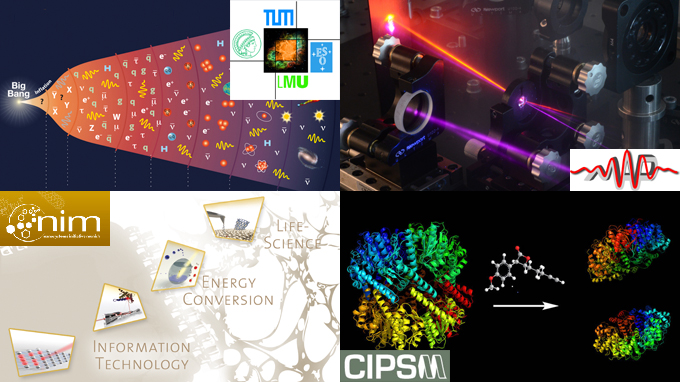Former Clusters of Excellence
 Clusters of Excellence with participation of the Physics Department.Listed are the names of the researchers from the Physics Department involved in these clusters.
Clusters of Excellence with participation of the Physics Department.Listed are the names of the researchers from the Physics Department involved in these clusters.
Origin and Structure of the Universe
How did the Universe form? What are the fundamental forces and structures? Why are there galaxies, stars and planets? What led to the formation of chemical elements? What does the future hold for the cosmos?
These questions demonstrate rather accurately the themes scientists have to deal with when studying the Universe. To this day, scientists have not yet found a satisfactory explanation of how the cosmic building blocks of matter, space, and time as well as the basic forces have developed. Also, the question is still open as to why the (nowadays generally accepted) standard model of physics cannot explain a number of phenomena of modern particle and astrophysics? the reason why physicists have designed theoretical models such as supersymmetry and string theory.
The Excellence Cluster "Origin and Structure of the Universe" was established at the Technische Universität München (TUM) in October 2006 within the framework of the so called Excellence Initiative and was initially committed to run for five years. In 2012, the funding of this unique and internationally recognized Research Center was renewed for another five years.
This interdisciplinary research project unifies the physics faculties of TUM and Ludwig-Maximilians-Universität (LMU). Other partners are the Universitätssternwarte (University Observatory) of the LMU, several Max-Planck-Institutes and the European Southern Observatory (ESO). About 200 scientists are working within more than 45 research groups to decode the great secret called "Universe". The Excellence Cluster is located at the Research Center Garching.
- Spokesperson:
- Prof. Stephan Paul
- Participants:
- Andrzei Buras, Nora Brambilla, Martin Beneke, Shawn Bishop, Laura Fabbietti, Franz von Feilitzsch, Peter Fierlinger, Walter Henning, Alejandro Ibarra, Norbert Kaiser, Reiner Krücken, Lothar Oberauer, Michael Ratz, Elisa Resconi, Peter Ring, Stefan Schönert, Wolfram Weise
Nanosystems Initiative Munich (NIM)
The cluster “Nanosystems Initiative Munich” (NIM) is one of the Clusters of Excellence which have been selected on 13th October 2006 by the German government's “ Excellence Initiative”. NIM brings together research groups in the Munich area covering the fields of physics, biophysics, physical chemistry, biochemistry, biology, electrical engineering, and medicine.
It merges their combined expertise on man-made and biological nanoscale systems into a coherent and focused nanoscience cluster. While many individual nanoscale building blocks and components have been devised in recent years using top-down and bottom-up strategies, little is known about their integration into entire functional systems.
The overarching vision guiding the research in this cluster will therefore be to design, fabricate and achieve control of a broad range of artificial and multi-functional nanoscale systems, and to unlock their potential for possible applications in fields as diverse as future information technologies, the life sciences, or combinations of both. To this end, it will be essential to gain a fundamental understanding of their properties and behavior, which range from being purely quantum mechanical to being governed mainly by stochastic effects.
- Deputy spokesperson:
- Friedrich Simmel
- Participants:
- Gerhard Abstreiter, Andreas Bausch, Hendrik Dietz, Jonathan Finley, Rudolf Gross, Dirk Grundler, Alexander Holleitner, Thorsten Hugel, Katharina Krischer, Matthias Rief, Martin Stutzmann, Peter Vogl
Munich Center for Integrated Protein Science (CIPSM)
The overall aim of CIPSM is to foster an integrated protein science approach in order to make seminal contributions to our understanding of protein function in living systems. In addition, we plan to develop new technologies to study, manipulate and quantify protein function in the natural environment. On the fundamental level of biology, we will follow three major lines of research: (I) analysis of protein functions and networks in genome expression and repair, (II) systemic study and intervention of protein function and dysfunction in neurobiology and medicine and (III) analysis of proteins in cellular architectures and for compartmentalisation.
- Participants:
- Hendrik Dietz, Matthias Rief, Martin Zacharias
Munich-Centre for Advanced Photonics (MAP)
Laser light is a pivotal tool of the XXIst century. The internet features several hundred million entries about lasers, laser-based sources and techniques, briefly: photonics, which ranks among the key disciplines in technology-development roadmaps of major economies. They offer the potential for pushing the frontiers of science as well as of biomedical and information technologies. Founded in 2006 and building on an established network of collaborations between physicists, chemists, biologists and physicians, MAP aims - in cooperation with the industry - at exploiting this potential by drawing on state-of-the-art low- (<10 kev="" and="" high-energy="" 10="" photonic="" tools="" p="">
MAP research is guided by several long-term objectives and visions. In the microcosm they centre on electronic phenomena relevant to technology and life: the exploration of ultimate limits of electronics and routes for approaching it as well as insight into the microscopic origin of diseases and into ways of combating them. A major goal in the macrocosm is a cost-effective instrumentation for the early diagnosis of diseases including early cancer detection, and for cancer therapy with particle beams before the emergence of metastases.
The mission of MAP is to create an unparalleled infrastructure in photonics, on the long run sustained by the Centre for Advanced Laser Applications - CALA, and a lasting bridge between physical and biomedical sciences. This allows for the pursuit of challenging scientific, technological and societal endeavours just as training young scientists and promoting their careers in a uniquely inter-disciplinary environment.
- Participants:
- Johannes Barth, Peter Feulner, Reinhard Kienberger, Fritz Parak, Franz Pfeiffer, Peter Ring